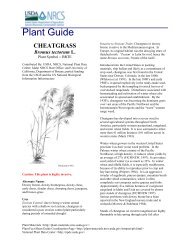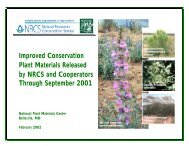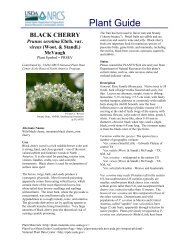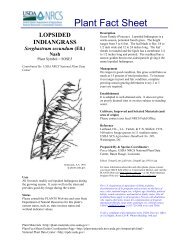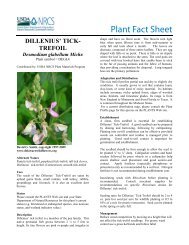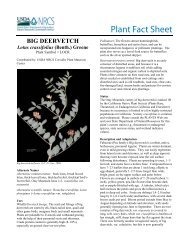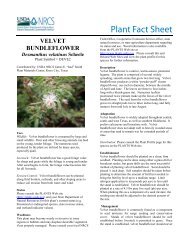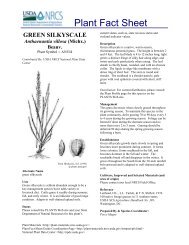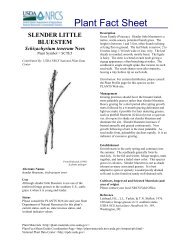(Sorghastrum nutans[ L.]Nash)Plant Fact Sheet - USDA Plants ...
(Sorghastrum nutans[ L.]Nash)Plant Fact Sheet - USDA Plants ...
(Sorghastrum nutans[ L.]Nash)Plant Fact Sheet - USDA Plants ...
You also want an ePaper? Increase the reach of your titles
YUMPU automatically turns print PDFs into web optimized ePapers that Google loves.
INDIANGRASS<br />
<strong>Sorghastrum</strong> <strong>nutans</strong> (L.) <strong>Nash</strong><br />
<strong>Plant</strong> Symbol = SONU2<br />
Contributed by: <strong>USDA</strong> NRCS Jimmy Carter <strong>Plant</strong><br />
Materials Center, Americus Georgia<br />
Mike Owsley<br />
Jimmy Carter <strong>Plant</strong> Materials Center<br />
Americus, Georgia<br />
Alternate Names<br />
Indian grass and yellow indiangrass<br />
Uses<br />
Erosion control: Critical areas, roadside cover and areas<br />
subject to wind erosion<br />
Livestock: Indiangrass growing singly, or in mixtures with<br />
other native grasses, provide livestock forage on<br />
rangeland, pastureland, and hayland. Forage quality is<br />
high when green and fair when mature.<br />
Pollinators: Indiangrass constitutes part of the native<br />
plant community in support of pollinators.<br />
Restoration: Indiangrass is used in restoration of native<br />
prairie areas and longleaf pine understory sites.<br />
Wildlife: White-tailed deer browse Indiangrass foliage. A<br />
mix of Indiangrass and other native warm-season grasses<br />
and forbs provide nest, brood and escape cover for<br />
bobwhite quail. Indiangrass seed is consumed by birds<br />
and small mammals.<br />
Status<br />
Please consult the PLANTS Web site and your State<br />
Department of Natural Resources for this plant’s current<br />
<strong>Plant</strong> <strong>Fact</strong> <strong>Sheet</strong><br />
status (e.g., threatened or endangered species, state<br />
noxious status, and wetland indicator values).<br />
Weediness<br />
This plant may become weedy or invasive in some<br />
regions or habitats and may displace desirable vegetation<br />
if not properly managed. Please consult with your local<br />
NRCS Field Office, Cooperative Extension Service<br />
office, state natural resource, or state agriculture<br />
department regarding its status and use. Weed<br />
information is also available from the PLANTS Web site<br />
at http://plants.usda.gov. Please consult the Related Web<br />
Sites on the <strong>Plant</strong> Profile for this species for further<br />
information.<br />
Description and Adaptation<br />
Indiangrass (<strong>Sorghastrum</strong> <strong>nutans</strong> [ L.] <strong>Nash</strong>), is a native,<br />
rhizomatous, perennial, warm-season bunchgrass. It is a<br />
major component of the tall grass vegetation which<br />
dominated the prairies of the central and eastern United<br />
States. It is common in longleaf pine understory<br />
communities. Indiangrass grows 3 to 7 feet tall. Even<br />
when young, it can be distinguished by the “rifle-sight”<br />
ligule occurring where the leaf blade attaches to the leaf<br />
sheath. The leaf blades grow to 3 feet long, and narrow at<br />
the point of attachment. The seed head is a single, narrow,<br />
bronze-yellow plume-like panicle maturing to brown. The<br />
seed is light and fluffy with small awns attached. There<br />
are approximately 175,000 seeds per pound. Indiangrass<br />
is adapted from Florida, north to Canada, and west to<br />
North Dakota, Wyoming, and Utah. It grows well in<br />
deep, well-drained floodplain soils and in well-drained<br />
upland sandy loam soils. It is tolerant of poor and welldrained<br />
soils, acid to alkaline conditions, and textures<br />
from sand to clay.<br />
Indiangrass distribution from <strong>USDA</strong>-NRCS PLANTS<br />
Database.<br />
For updated distribution, please consult the <strong>Plant</strong> Profile<br />
page for this species on the PLANTS Web site.
Establishment<br />
Indiangrass requires a soil temperature above 50°F for<br />
germination. Dormant seedings have not been successful.<br />
The optimum time to plant is from early May to late June.<br />
In the southern states planting is recommended after last<br />
threat of frost but before hot dry conditions of summer.<br />
The seed is light and has small awns attached. Debearding<br />
removes the awns producing a free-flowing product. The<br />
planting site should be free of weeds. A moist, firm<br />
seedbed is essential. Firming the soil with a roller packer<br />
before and after seeding helps to ensure that the seed is<br />
placed at the recommended seeding depth of 1/8 to 1/4<br />
inch. Packing after planting is especially important if<br />
seeded with a broadcast spreader.<br />
If drilled for pasture conditions, use 6 to 8 pounds PLS<br />
(pure live seed) per acre. For broadcast seedings, use 10<br />
pounds per acre. The seeding rate for mixed pastures of<br />
Indiangrass, switchgrass, big bluestem and little bluestem<br />
are 2 pounds PLS each per acre. Seeding rates for other<br />
uses will normally be lower than the pasture rate.<br />
Indiangrass has strong seedling vigor, but stands develop<br />
slowly where there is competition from broadleaf weeds<br />
and cool-season grasses. To minimize the amount of<br />
exposed weed seed in seedings use no-till establishment<br />
methods. Cool season grasses must be controlled before<br />
seeding. Indiangrass is tolerant to most broadleaf<br />
herbicides. It is important to follow label instructions for<br />
application amounts and grazing requirements.<br />
The most common cause of failure of native warm-season<br />
grasses is a loose seedbed and improper seed placement.<br />
The seedbed should be firm, showing only a light<br />
footprint.<br />
Management<br />
Fertilizing with moderate amounts of phosphorus and<br />
potassium are recommended for establishment.<br />
Applications of nitrogen are not recommended until the<br />
grass is established. In the establishment year, 20 to 40<br />
pounds per acre of phosphorus and potassium may be<br />
applied in late summer. In the second year, phosphorus<br />
and potassium may be applied in the early summer at a<br />
rate of 40 to 80 pounds per acre. In future years fertilizer<br />
may be applied to enhance vigor for forage production<br />
and erosion control. Indiangrass used for purposes other<br />
than pasture will require minimal if any fertilization.<br />
Properly managed and maintained stands of Indiangrass<br />
should not require replanting. Poor stands can be<br />
rejuvenated using management practices, such as<br />
controlled grazing, the application of herbicides and<br />
fertilizer, and prescribed burning. Nitrogen, phosphorus,<br />
and potassium fertilizer should be applied according to<br />
soil tests.<br />
In rotational grazing systems, remove no more than ½ the<br />
above ground growth (no shorter than 8 to 12 inches).<br />
With care, the stand will last indefinitely. Forage quality<br />
will remain high until the seed head emerges. Grazing<br />
should begin when grass is 18 to 20 inches in height.<br />
Overgrazing can damage the stand and should be stopped<br />
when the plants are grazed to within 8 inches of the soil<br />
level. Leaving this much stubble before frost allows the<br />
plants to store carbohydrates and ensures the production<br />
of vigorous plant growth in the spring.<br />
Prescribed burns increase vigor in the plant and improve<br />
its ability to control erosion and increase forage<br />
production. They are essential in restoration and wildlife<br />
plantings.<br />
Pests and Potential Problems<br />
During exceptionally wet summers Indiangrass can be<br />
attacked by rust. Armyworms can become a problem in<br />
dry years.<br />
Environmental Concerns<br />
Cultivars developed for forage production may dominate<br />
native Indiangrass stands in natural plant communities<br />
and restoration sites.<br />
Control<br />
Please contact your local agricultural extension specialist<br />
or county weed specialist to learn what works best in your<br />
area and how to use it safely. Always read label and<br />
safety instructions for each control method. Trade names<br />
and control measures appear in this document only to<br />
provide specific information. <strong>USDA</strong> NRCS does not<br />
guarantee or warranty the products and control methods<br />
named, and other products may be equally effective.<br />
Cultivars, Improved, and Selected Materials (and area<br />
of origin)<br />
‘Holt’ (NE), ‘Llano’ (NM), ‘Lometa’ (TX), ‘Osage’ (KS<br />
and OK), ‘Oto’ (NE and KS), ‘Rumsey’ (IL),<br />
‘Tomahawk’ (ND and SD); ‘Americus’(GA/AL);<br />
Cheyenne (informal release, OK); source identified<br />
releases from northern, central, and southern Iowa, and<br />
northern and western Missouri.<br />
Prepared By: Jimmy Carter <strong>Plant</strong> Materials Center<br />
Citation<br />
Owsley, Mike, 2011. <strong>Plant</strong> fact sheet for Indiangrass<br />
(<strong>Sorghastrum</strong> <strong>nutans</strong>[ L.] <strong>Nash</strong>). <strong>USDA</strong>-Natural<br />
Resources Conservation Service, Jimmy Carter PMC<br />
Americus, Georgia 31719.<br />
Published: February, 2011<br />
Edited: e.g., 08Sep2009 rg, 08Sep2009 jfh; 17Sep2009<br />
jfe, 10 Feb2011 cmo<br />
For more information about this and other plants, please<br />
contact your local NRCS field office or Conservation<br />
District , and visit the<br />
PLANTS Web site or the <strong>Plant</strong><br />
Materials Program Web site


![(Sorghastrum nutans[ L.]Nash)Plant Fact Sheet - USDA Plants ...](https://img.yumpu.com/19288674/1/500x640/sorghastrum-nutans-lnashplant-fact-sheet-usda-plants-.jpg)
